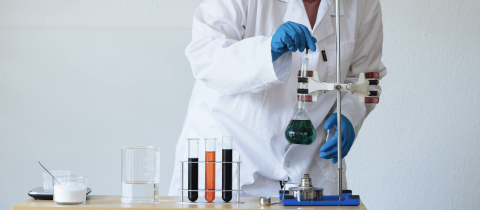Solvents! What do you think of? Nail polish remover? Dry cleaning fluid? Yes, those are solvents. But there’s a lot more to the story. Chemistry would not be possible without the use solvents. Most chemical reactions are carried out in solvents and any time you hear of some substance being extracted from a plant or herb, you’re looking at a solvent in action. The simplest and safest solvent is water. When you brew coffee or tea you are using water as a solvent. But the majority of substances chemists deal with are not soluble in water and require the use of an organic solvent. In this case the term “organic” is used in the proper chemical sense, referring to compounds that have a framework of carbon atoms. Although some solvents are safer than others, all solvents can cause toxic effects. There are no safe organic solvents, only more and less toxic ones.
“Green chemistry” emphasizes the use of the safest possible substances in the most efficient fashion with the least environmental impact. Recently, a team of natural products chemists at Leiden University, Netherlands, discovered a set of truly green solvents. These revolutionary, nontoxic solvents has been christened as “natural deep eutectic solvents”or NADES. So where do you look for a truly green solvent? You don’t get much greener than plants. Plants are true chemical factories, producing a wealth of compounds. The assembly line begins with photosynthesis, the process by which plants take up carbon dioxide and water to form glucose. This is the raw material that together with minerals from the soil is used by the plant to yield a wide array of compounds that serve purposes ranging from deterring insects to synthesizing chlorophyll without which photosynthesis itself would not be possible.
Virtually all chemical reactions take place in solution meaning that the starting materials must be soluble. In general compounds are soluble either in water or in oils, both of which are plentiful in plants. But it turns out that there are compounds involved in biosynthetic pathways that are not soluble in either phase. So how do they engage in chemical reactions? This has puzzled scientists, but there now appears to be an answer. It turns out that there are combinations of solid compounds abundant in plants that under certain conditions form liquids. For example malic acid and fructose, found in apples, combined under the right conditions for a liquid that will dissolve substances that are insoluble in water or oil. Other examples include lactic acid and glucose, and sucrose and choline chloride. Some sixty combinations of solids that can form liquids under certain conditions are now known and are termed “natural deed eutectic solvents” or NADES. The attraction of these solvents is that they are less toxic than conventional organic solvents yet have the same capability of extracting compounds from plant sources. For example, there is a great deal of interest in antioxidants in plants because of their potential health benefits. Many of these fall into the chemical family known as flavonoids which either for research purposes or for the preparation of dietary supplements have been traditionally extracted with organic solvents such as chloroform and ethyl acetate. However these are not exactly environmentally friendly and can also leave unacceptable residues in the extracts. NADES are non-toxic and being readily biodegradable present no environmental issues and are therefore deemed to be “greener.” They are very promising candidates for future applications in pharmaceutical, cosmetic, dye, fragrance and agrochemical industries. NADES just may be the solution to the problem of making the righty solution.







